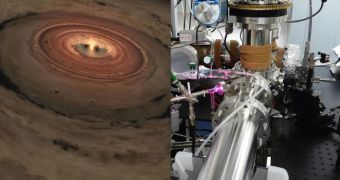A group of experts from the NASA Jet Propulsion Laboratory (JPL) in Pasadena, California, recently conducted a study meant to assess the conditions required for organic molecules to enter a prebiotic states. Such researches could reveal more about how life began here on Earth.
A prebiotic state means that organic molecules interact in a way that could potentially lead to the emergence of life over time. In order to simulate this intricate process, JPL scientists froze molecules that contained carbon inside ice, and then zapped them with powerful lasers.
The conditions they created in their investigation were very similar to what one could expect to find in the outer solar system, or on the surface of moons such as Saturn's Enceladus and Jupiter's Europa.
The origin of life on Earth is still a rather complex subject, especially considering the theory of panspermia, which lately received numerous independent confirmations. Basically, it holds that both water and life were brought here by comets and asteroids.
What the JPL team basically did was provide the first-ever, direct look at the organic chemistry that takes place on icy particles. When taking into account that most of the Universe functions at very low temperatures, and that billions of planets may be out there, this study becomes all the more important.
Ice and organic particles exist not only on planets and their moons, but also in the very cold place between stars. Scientists believe that this is where life may have originated. They say that it gets delivered everywhere, but only flourishes where the necessary conditions are found.
“The very basic steps needed for the evolution of life may have started in the coldest regions of our Universe. We were surprised to see organic chemistry brewing up on ice, at these very cold temperatures in our lab,” JPL expert and lead study author, Murthy Gudipati, explains.
He explains that the new study analyzed the behavior of organic compounds at temperatures of just 5 Kelvin (minus 450 degrees Fahrenheit, or minus 268 degrees Celsius). The compounds they used are called polycyclic aromatic hydrocarbons (PAH), and they were found to permeate the Universe.
According to data from the NASA Spitzer Space Telescope, PAH are even found in the protoplanetary disks orbiting newly formed stars. These are the structures from which planets, moons, asteroids and comets take shape.
“PAHs are strong, stubborn molecules, so we were surprised to see them undergoing these chemical changes at such freezing-cold temperatures,” Gudipati says. He adds that the laser technique used to study the compounds' reactions is called Matrix Assisted Laser Desorption and Ionization (MALDI).
Details of the study were published in the latest issue of the esteemed Astrophysical Journal Letters.

 14 DAY TRIAL //
14 DAY TRIAL //